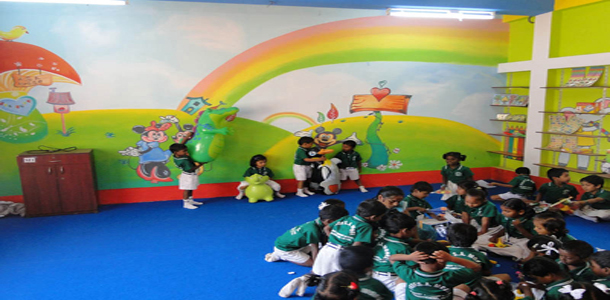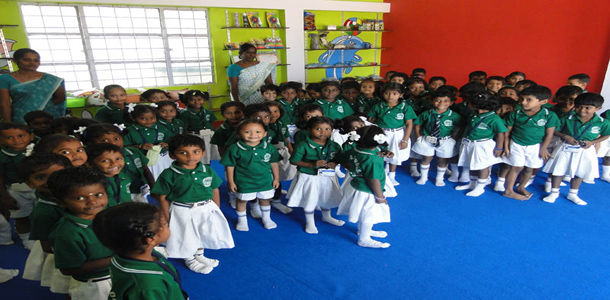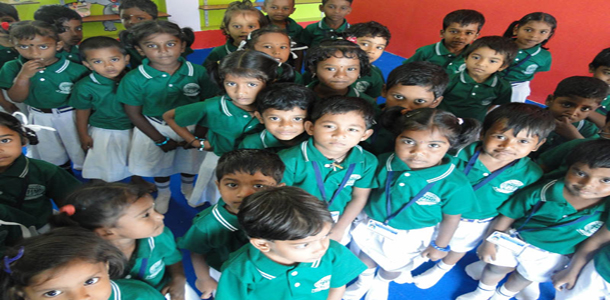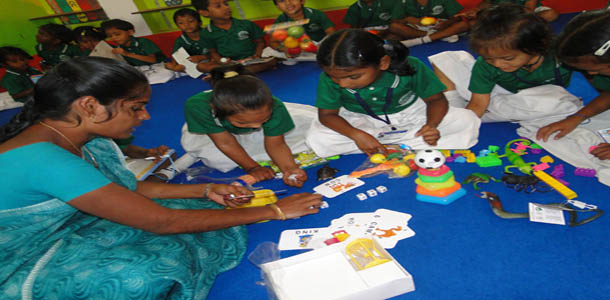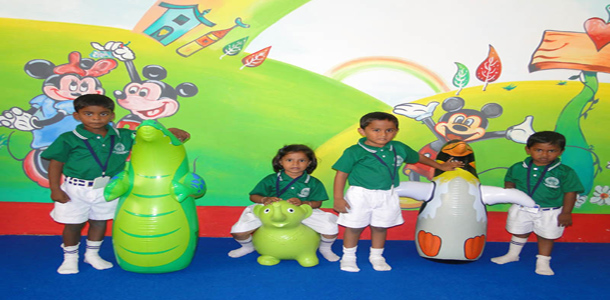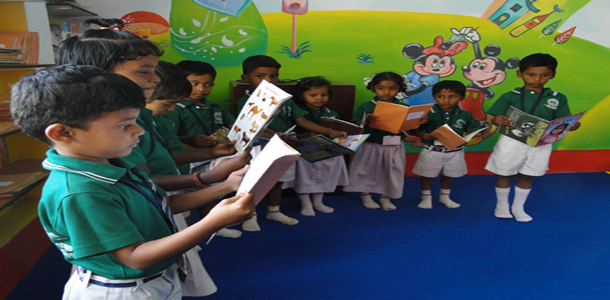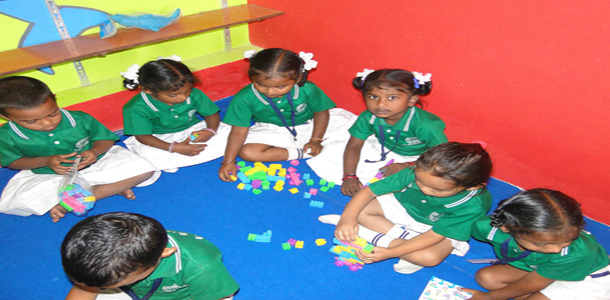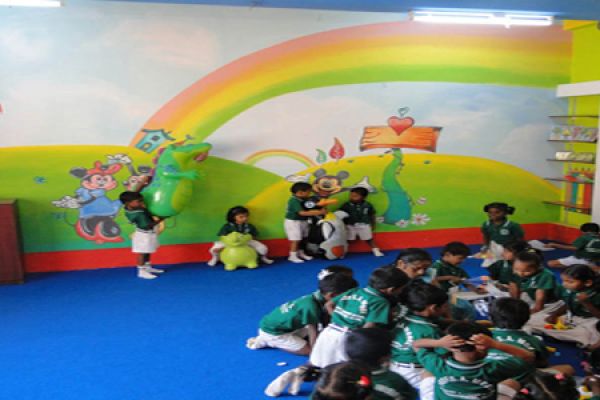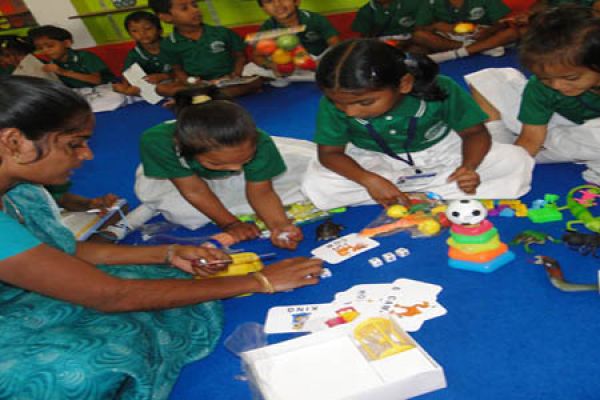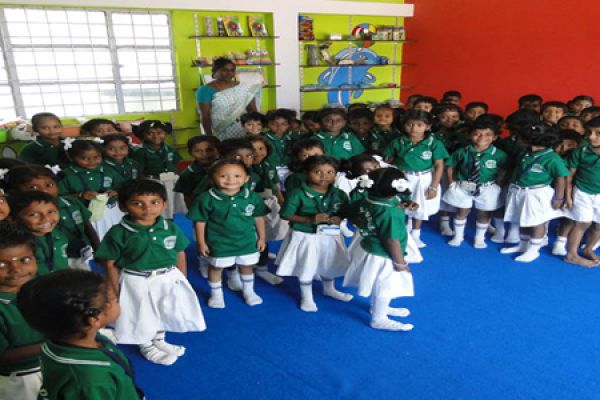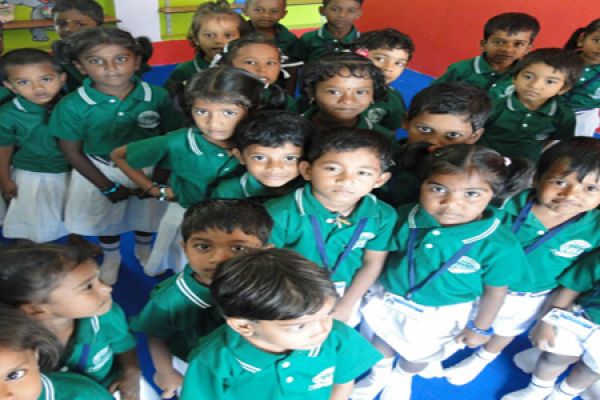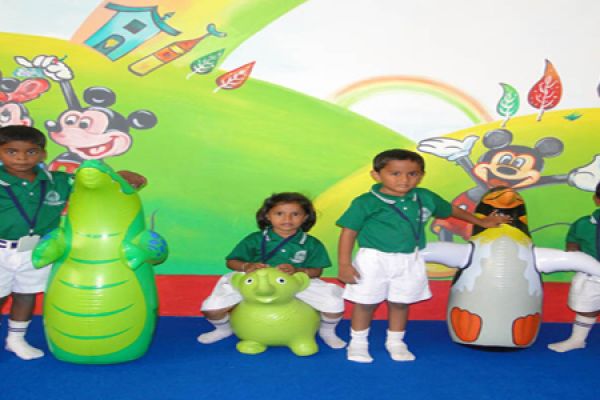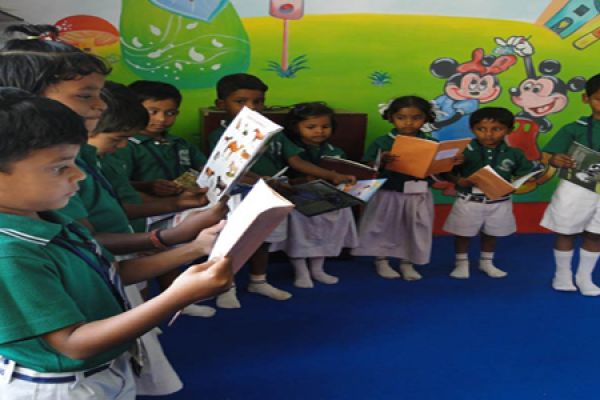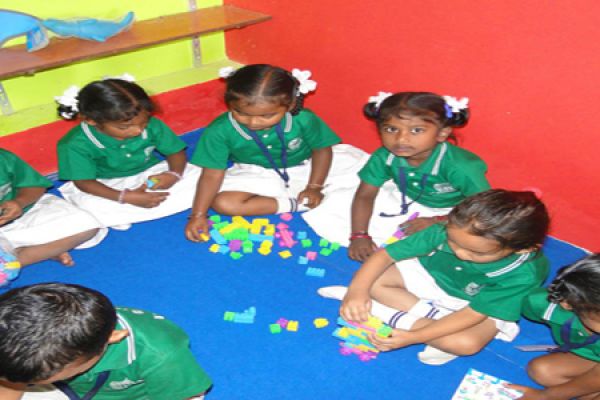- Details
- Written by Administrator
- Category: Uncategorised
- Hits: 3762

LIBRARY:
Our school library is a welcoming place for study and reading. The school library supports the students and teachers by providing access to current, adequate and appropriate information resources. The library provides many children with their first chance to use and enjoy a library. It also ensures that all the students, teachers and staff are effectively using the ideas and information. The library encourages the love of reading and development of student’s independent learning skills. Our library has both printed as well as audio-visual material like CD-ROM and DVDS. There are plenty of books, encyclopedias, picture books, activity books, dictionaries etc. The library has books on literature in English, Tamil and Hindi. There is a good seating capacity for the children in the library. Students of all classes visit the library. They refer books and participate in library activities. The library is designed with a view of making it modern and student friendly. The books are classified and shelved properly for easy access.
Reading is the first discipline that a new student of a language comes into contact with. It is here, in this discipline, that learners will begin to see how the language is put together to make sense. Reading is all about understanding the written word. Once the student starts reading for a while, they will want to progress to writing. Reading is an important skill that needs to be developed in children. Not only is it necessary for survival in the world of schools and (later on) universities, but in adult life as well. The ability to learn about new subjects and find helpful information on anything from health problems and consumer protection to more academic research into science or the arts depends on the ability to read. Reading by way of books, magazines expose kids to new vocabulary, knowledge and expands their horizon in totally.
- Details
- Written by Administrator
- Category: Uncategorised
- Hits: 390

WHY CHOOSE US:
Academic Excellence:
We help students develop critical thinking skills and creativity as well as to master the subjects with ease.
Speed learning:
Due to individual attention and extensive tracking programs our students hold Records in mastering all subjects with outstanding results.
The best teachers:
Teachers make the biggest difference. Our highly qualified and caring teachers are passionate about education excellence.
Teacher to student ratio:
Students learn differently. Our individualized support and small classes determine the success of our students.
Educational Methodology:
An educational methodology that speeds up mastering curriculum, encouraging students to think out of the box, to believe in themselves, to persist in problem-solving, to take thoughtful risks and to celebrate small wins.
Integrated Technology:
We focus on building our students experience and comfort with integrated technology. There are interactive classrooms with modern technology implementation.
Attractive fees:
No deposits. No hidden fees.
Parent-School Relationship:
We pride ourselves on being an inclusive family-oriented school with a strong bond to our Parent School Relationship. And this is reflected in the close relationships we have with the parents of our students. But our family ties go deeper than this, extending even to our student alumni who, until today, come back from time to time for a nostalgic look at the school or to get advice on their further education. And for our present students, the sense of family extends beyond the school grounds as they enthusiastically greet their teachers whenever they encounter them out in public after school hours.
- Details
- Written by Administrator
- Category: Uncategorised
- Hits: 937

PERSONALITY DEVELOPMENT:
We give importance to personality development of the child. We involve children in activities that improve awareness and identity, develop talents and potential. This helps the child to enhance the quality of life and contribute to the realization of their dreams and aspirations. Teachers involve students in formal and informal activities which includes : improving self-awareness, self-knowledge, skills and/or learning new ones, health, potential, social relations or emotional intelligence, developing strengths or talents and importance of time-management.

HEALTH AND FITNESS:
Our school understands the importance of health and fitness for children. Fitness as we know is a state of good health and well-being. More specifically, the ability to perform aspects of sports, occupations and other daily activities. This is generally achieved through proper nutrition, moderate-vigorous physical exercise and sufficient rest.
Fitness also refers to a person's ability to perform a specific task, possessing significant ability, i.e. endurance or strength. with an adaptability to cope with various situations. A overall fitness program improves a person in all aspects of fitness like - mental, social and emotional health, which are an important part of fitness.
Physical fitness can also prevent or treat many chronic health conditions brought on by unhealthy lifestyle. Working out can also help children sleep better and possibly lessen some mood disorders.
Childhood obesity and weight control:
Childhood obesity crisis is very predominant these days. We create awareness about childhood obesity to both the children and parents. Parents also look to schools to utilize every opportunity to expose children to physical activity programming. Physical education, after school physical activities, and sports make children move closer to health and fitness. Health and fitness is an important and beneficial interest to pursue at any age, but it can be particularly helpful to build dedication in these areas during the early years at the school. These pursuits include everything from exercising regularly and eating nutritiously to educating the children about how to get the most from their body and staying on top of their own preventative health care.
Achieving resilience through physical fitness promotes a vast and complex range of health-related benefits. Children who keep up physical fitness levels generally regulate their distribution of body fat and stay away from obesity. Abdominal fat, specifically visceral fat, is most directly affected by engaging in aerobic exercise. Strength training has been known to increase the amount of muscle in the body, however, it can also reduce body fat. Hormones, insulin, and an appropriate immune response are factors that mediate metabolism in relation to the abdominal fat. Therefore, physical fitness provides weight control through regulation of these bodily functions.

Mental Health Benefits of Exercising:
We believe that physical activity can improve mental health and well-being of the child. This improvement is due to an increase in blood flow to the brain and the release of hormones. Being physically fit and working out on a consistent and constant basis can positively impact the child's mental health and bring about several other benefits. Physical activity has been linked to the alleviation of depression and anxiety symptoms. Being fit can improve self-esteem. Working out can improve mental alertness, it can reduce fatigue and there is a reduction in stress levels. These things result in an increased opportunity for social interaction, allowing for improved social skills of children.
When children exercise, their body responds positively. Some of these responses are chemical in nature and others are behavioral. Either way, the evidence agrees overwhelmingly that regular physical exertion has positive effects on their mental health.
As they exercise, the stress hormones adrenaline and cortisol decrease in the body. At the same time, exercise stimulates the creation of endorphins, which are natural mood boosters and painkillers.
Exercise also boosts their spirits in other ways. Regular physical exertion is associated with increased self-confidence, positive self-image, and an elevated sense of control over life. They are also more likely to feel invigorated or energized if they exercise regularly, and these feelings can spill over into other areas of their life. Their increased energy could help with studying, other extra-curricular activities, or simply enjoying time with friends. The emotional impacts of exercising regularly are overwhelmingly positive.
Boosting the Immune system:
Physical activity boosts the immune system. This is dependent on the concentration of endogenous factors like metabolic hormones and growth hormones, body temperature, blood flow, hydration status and body position. Physical activity has shown to increase the levels of natural killer (NK) cells, NK T cells, macrophages, neutrophils and eosinophils, complements, cytokines, antibodies and T cytotoxic cells.
Dyslexia:
If a child is struggling with reading or writing, it can be difficult to know exactly what the problem is. There are lots of ways to help kids with reading and writing issues that succeed in our school.
· Specific instruction on identifying sounds, understanding how letters represent sounds in speech and decoding words.
· Specialized instruction, either one-on-one or in a small group.
· A reading program that focuses on using all the senses to learn - Multisensory Approach.
· Extra time for reading and writing.
· Access to the teacher's notes from the lesson to reduce the amount of note-taking.
· Simplified directions.
· Shortened assignments.
· Reading aloud so that the child hears stories above his/her reading level.
· For younger kids, reciting nursery rhymes and sing memory songs.
ETIQUETTES & MANNERISMS:
Etiquettes & Mannerisms are the most important traits that have to be inculcated into children from early childhood for the betterment of the self and others. Respect, kindness, and consideration form the basis of good manners and good citizen-ship.
We at the school believe that rather than being stiff and impose rigid rules, it is better to induce proper etiquette and mannerism to help students to get along with each other and avoid conflict. Etiquette is always about set of rules dealing with exterior form, while Manners are an expression of inner character. They can be easily learned if one does not know them, it is the outward manifestation of one's innate character and attitude toward life.
Our training covers behavior in talking, acting, living, and moving, enabling children in handling different types of interactions in most of the situations. We very well understand that manners indicate - whether or not a behavior is socially acceptable. Hence, it becomes more important to give awareness to students about social norms which are informally enforced through self-regulation and social policing and publicly performed. Basically emphasis is given to Hygiene, Courtesy & Cultural Norms.



